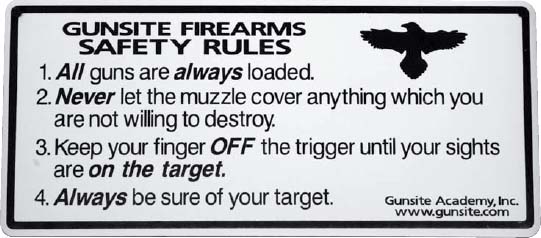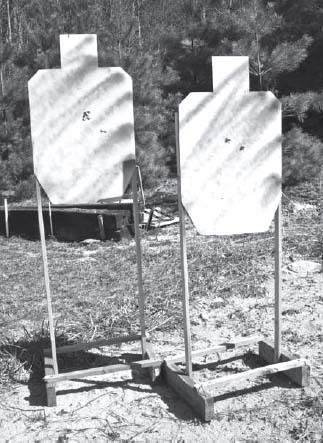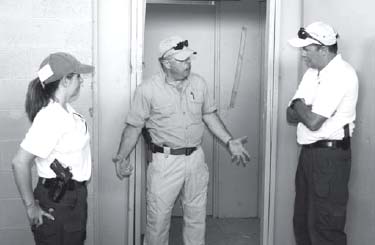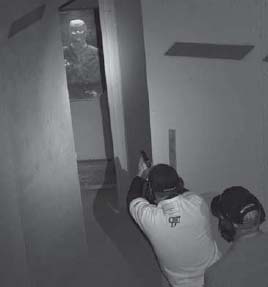
“But there are always the new graves, in some of them fellows you knew; there because of a faulty machine or bad judgment.” —Lieutenant Frank Luke, 1918
In the beginning of this book, there is a list of RULES. The first four rules apply to firearms safety, the next six rules to fighting with a gun. I have to give credit to where credit is due: the first four are courtesy of Jeff Cooper and the Gunsite Academy, the last six are simply expressions of common sense.
Throughout the text, where applicable, you have seen references to all 10 of these RULES. If you take nothing else from this book, these RULES, if followed, could be considered the credo of anyone carrying a defensive handgun. No doubt you or others will take issue with the training and evaluation suggestions, as well as those with regard to sights, lasers, lights, and ammunition. There is indeed more than one way to skin a cat, pick up a girl, eat a banana, or fight with a handgun. However, if you’ll use these 10 simple RULES as a guide, you can greatly enhance your level of personal protection.

Humans do a lot of things every day of their life, from the time you dig your eye boogers out in the morning until you put on your Batman pajamas at night. Most of the things we do are mundane, simple actions we don’t even think about, like driving our Prius and cramming fatty foods in our face until we have to loosen our belts two notches. Even though we don’t think about these things as we do them, we look like we’re good at it while we’re doing them.
Your personal protection should be just as incidental. It should not be complicated, it should not be some super tactical routine dreamed up by a tac-tard on TV or down at the local range. It should be as seamlessly integrated into your lifestyle as kissing your wife or husband on the cheek before bed or making sure your fly is zipped when you leave the restroom. Survival should come as natural to us as it does for all animals. We are, after all, driven by the same needs of safety, sustenance, and sex.
Some instructors and gun writers like to complicate the concept of self-defense with a handgun. The more complicated they can make it, the more they can charge you to take their training or the more articles than can sell. Admittedly, if you’re a member of SEAL Team Six, you have a lot of skills to learn. But those kinds of advanced gunfighting skills aren’t really needed in everyday life unless you’re a monster hunter. (I’m guessing it won’t be long until someone opens a zombie hunting school.)
When it comes to firearms safety, everyday survival, and the basics of personal protection with a firearm, the old axiom “keep it simple” applies. After all, all you really want to do is live out your life without interruption from vagabonds, pirates, thieves, and murderers. To do that you don’t need to be a prepper, someone others call a “tac-tard,” or even a super ninja. This brings us to what I call “Gunfighter Logic”—10 simple RULES for using a handgun for personal protection.
Well, no, not really. Some guns are unloaded. The thing is, if we treat all guns as if they are loaded, the less likely we are to do stupid things with them, like pointing them at ourselves, your wife, or your kids. Just like you often read in the paper or hear on the news, husband shoots wife and says, “I thought the gun was unloaded.”

If there was only one rule of gun safety, this would be it. In fact, it is the first rule I teach and the one rule I demand compliance with. If gun owners followed just this one safety rule for the rest of eternity, accidental deaths and injuries from firearms would be committed only by the blind. And guns that were dropped on toes.

Never point a gun at something you do not want holes in. This includes when you are being tactical, and your own body parts.
Why would you do this? To make sure you don’t inadvertently pull the trigger when you are not ready. The firearms instructor who accidently shot himself in the leg at my old department violated RULE No. 2 for sure when he pointed the pistol at his leg. However, had he not also violated RULE No. 3, he would probably have continued to offer less than acceptable training to the police officers he took to the range. By the way, he did not cover any of these rules with me on our first trip to the range.

Are your sights on the target? Do you intend to shoot that target? If the answer to both questions is “Yes,” then and only then is it okay to put your finger on the trigger.
What does this mean? It means you only shoot at things that are okay to shoot at. Can you shoot at paper targets? Sure. But, be careful about what’s beyond them. I once had a dog that liked to sneak down range. I broke him of this unsafe habit by accident. Once he got behind the target and received a hole in his ear. So go ahead, shoot the bad guy. Just make sure a family member isn’t standing behind them.

Bullets make holes in paper targets and then they make holes in what’s behind them.
Carrying a handgun for protection is an option available to you unless you live in a location where the politicians believe citizens are sheep. Most of us carry several personal items like a watch, cell phone, wallet, and maybe even a knife everywhere we go. If you are going to rely on a handgun for personal protection, you have to be willing to carry it and you must be willing to use it. If that’s a commitment you cannot make, buy pepper spray, a Rottweiler and a thick leash, or hire a bodyguard.
When I was conducing firearms training for my department, I’d show a clip of John Wayne’s last movie The Shootist. It was the part of the film where Wayne’s character, J.B. Books, was giving “young Gillom” a shooting lesson. The most important advice Books gave the young boy was that “You gotta be willing.” You need the right mindset. You have to be willing to fight and you have to be prepared to fight to the end—like you’re killing snakes.

Maybe a gun is not for you. Don’t be ashamed. Recognize that fact and prepare accordingly by some other means.

To protect yourself with a handgun, you have to have it with you. If you’re accosted in the parking lot of a Piggly Wiggly by some meth-fueled freak and your handgun is at home in that expensive gun safe you purchased, it is as worthless as a nun in a brothel. Pick a gun you can carry and will carry and then carry it!
I’m confused by and opposed to the requirements placed on those seeking a concealed carry permit. I’m not opposed to mandated training, as long as you are the one mandating the type and amount of training you must have.
That having been said, if you’re going to carry a gun, you need to know how to run it. A gun is, after all, a very simple tool. But, in a life or death situation, you will experience the loss of fine motor skills and likely have tunnel vision, auditory exclusion, and various other physical anomalies happen to you. When it all goes to hell in a hand basket, you need to be prepared to manipulate your handgun without conscious thought.
Know how to load your gun, operate your gun, clear stoppages, shoot your gun, unload your gun, draw your gun, and holster your gun. Know it like you know your name and practice it every chance you get and can afford.

It cannot protect you if you leave it at home.
The old saying “It’s better to be judged by 12 than carried by six,” or the more common “Anybody tries that on me and I’ll shoot the SOB” might sound cool and macho but it’s all bravado. Say it all you want, it won’t keep you alive or scare anyone away.

Continually develop and improve your weapon-craft. You cannot practice too much.

Those who teach concealed carry classes often get the question, “How will I know if I will be justified if I shoot someone?” Here is the answer to that question so you can quit asking it and be a good citizen by going and telling all your friends so they don’t ask it: you won’t know.
Reality is arguably 90 percent perception. Your perception of a situation is your reality. Perceptions can be 90 percent wrong, but our perceptions are what we must act upon. What matters is your ability to convey your perception of a situation to the police, a prosecutor, your lawyer, or a jury.
After a violent fight, I once arrested a man who claimed he thought I was a giant snake coming into his apartment to eat him. He was so spaced out from huffing gold paint I honestly believed that was his true perception of the situation. I’m not sure if the jury believed it or not, but either way it wasn’t logical, which is why he went to jail.
If you believe the only way you can survive without grave injury is to shoot your attacker, then you are negligent in your efforts to survive if you do not pull the trigger. If you thought your attacker was a werewolf, zombie, or your mother-in-law, you might have trouble in court later. I’m just saying.
Don’t be stupid. Don’t put yourself in situations you cannot defend either physically or morally. Stay out of the bad side of town, don’t park in dark areas, and avoid shady characters. If you end up in a gunfight, move fast, find cover, don’t stand in doorways, linger in hallways, or hesitate. If you are at a bar and get in a fight, don’t go home and get your gun or wait on the guy in the parking lot. If you catch a woman sleeping with your husband, don’t shoot her unless she’s trying to shoot you while in the throes of passion.
When you shoot, shoot to center mass of the available target. Shoot until the threat no longer exists. Shoot ’em to the ground, then call 9-1-1. Remember, being justified does not give you the right to take a life, only to use deadly force to stop a lethal attack. The law defines “attempts to kill” as murder.
Okay, maybe not everything. Back when I was young and camo was my work uniform, I once woke up outside of Fort Knox, Kentucky, in the passenger seat of a convertible Ford Mustang. It was daylight. I looked over in the driver’s seat and, to my horror, I was looking at the blondest woman I’d ever seen. Not only was she blonde, she looked like she had been a volunteer at a make-up factory. She also disproved the old adage that any girl looks good in a convertible. There’s a reason they keep the insides of nightclubs dark.

Have a plan. Use common sense. Think!
Tragic mornings with strange women in convertibles aside, in the world of gunfighting, you cannot shoot what you cannot see. Neither can you justifiably identify a threat if you cannot see your attacker. Light also equals control. Bad guys are like vampires. (Don’t tell the jury that.)
Even if you don’t carry a handgun, carry a light and use it. Another light gadget that’s a good idea is a laser. If a fiend attacks you in the dark, shine a Surefire in his face and paint his chest with a bright red dot—without ever pulling a trigger, you just might convince him he screwed with the wrong citizen.

Bad guys and monsters do not like light. Use that knowledge to your advantage.
Bad guys may not give any visual indication they’ve been hit when you shoot them, and if you’re scared bad enough to ruin your underwear, you might miss. Expect your worst shot in practice to be your best shot when a hoodlum is trying to stick a switchblade in your gut.
What I’m saying is that you might run out of ammo and need more. On top of that, handguns are not all that great at stopping a fight. They are not in the same league as a shotgun or a rifle. When you’re out and about, have a reload with you. When you are at home, have a long gun where you can get to it. Just in case. Oh, and obviously, it will be harder for the bad guy to shoot you if you are behind something.

A complete personal safety plan involves a long gun, either a shotgun or rifle (and sometimes both, when you can manage them!).